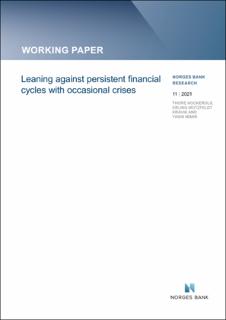| dc.contributor.author | Kockerols, Thore | |
| dc.contributor.author | Kravik, Erling Motzfeldt | |
| dc.contributor.author | Mimir, Yasin | |
| dc.date.accessioned | 2021-11-04T07:37:30Z | |
| dc.date.available | 2021-11-04T07:37:30Z | |
| dc.date.issued | 2021 | |
| dc.identifier.isbn | 978-82-8379-206-5 | |
| dc.identifier.issn | 1502-8190 | |
| dc.identifier.uri | https://hdl.handle.net/11250/2827723 | |
| dc.description.abstract | Should central banks use leaning against the wind (LAW)-type monetary or macroprudential policy to address risks to financial stability? We first assess LAW as a one-off (nonsystematic) policy using an estimated large-scale dynamic stochastic general equilibrium (DSGE) model with empirically plausible persistent financial cycles and a stylised regime-switching (RS) framework of occasional crises. We then evaluate policy-rule based (systematic) LAW using an endogenous RS version of our DSGE model with financial crises, effective lower bound (ELB) on interest rates, and an asymmetric LAW policy. Our findings do not support LAW by monetary policy because the costs of depressing the economy in normal times far outweigh the benefits of a less likely and less severe crisis. LAW increases inflation volatility significantly as it amplifies the effects of supply shocks on inflation. It also leads to higher long-run output costs in the case of nonsystematic policy and to a lower mean inflation rate in the case of systematic policy. The latter also results in more frequent ELB episodes due to the lower mean inflation rate it induces. We find that LAW is only advisable if the policymaker cares more about output stability relative to inflation stability or if financial cycles are less persistent, exclusively under systematic LAW. Higher long-run capital requirements in normal times address risks to financial stability better as they reduce the fluctuations in inflation and output considerably. | en_US |
| dc.language.iso | eng | en_US |
| dc.publisher | Norges Bank | en_US |
| dc.relation.ispartofseries | Working Paper;11/2021 | |
| dc.rights | Attribution-NonCommercial-NoDerivatives 4.0 Internasjonal | * |
| dc.rights.uri | http://creativecommons.org/licenses/by-nc-nd/4.0/deed.no | * |
| dc.subject | JEL: E52 | en_US |
| dc.subject | JEL: E58 | en_US |
| dc.subject | JEL: G01 | en_US |
| dc.subject | leaning against the wind | en_US |
| dc.subject | monetary policy | en_US |
| dc.subject | financial cycle | en_US |
| dc.subject | macroprudential policy | en_US |
| dc.title | Leaning against persistent financial cycles with occasional crises | en_US |
| dc.type | Working paper | en_US |
| dc.description.version | publishedVersion | en_US |
| dc.subject.nsi | VDP::Samfunnsvitenskap: 200::Økonomi: 210::Samfunnsøkonomi: 212 | en_US |
| dc.source.pagenumber | 107 | en_US |

